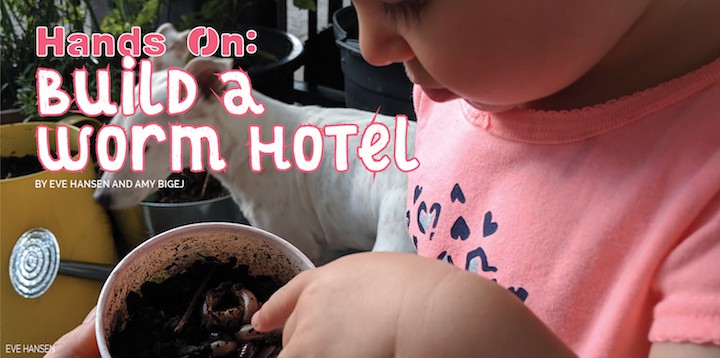
Construct a quick-and-easy “earthworm hotel” and dig into the mysteries of the worm kingdom. By Eve Hansen and Amy Bigej
Worms can be squiggly and a little icky to us humans, but they are fascinating creatures that do a lot of important work. Those wiggly little guys are a major part of our ecosystem, constantly digesting, composting and enriching the nutrients in the soil. They ventilate soil by moving through it. They are also great recyclers. They break down raw material by digesting it and turning it into compost, which they leave behind in what are called castings. They also help incorporate leaf litter into the top layers of the soil, which encourages fungi and bacteria to do the rest of the work and decompose the material. If you want healthy and happy plants, your soil should contain lots of worms to keep it healthy. It is usually hard to see earthworms doing their job because they work underground, in the dark. Making an earthworm hotel gives you and your kids a window into the fascinating process.
Materials
Empty 1- to 2-liter soda bottle
Scissors
Tape
Sand
Soil
3 to 4 worms (The fun way to get these is to dig them up. If you can’t find any, you can also buy them at most stores with a fishing section.)
Instructions
1. With grown-up help as needed, cut the top off of the plastic bottle.
2. Use tape to cover the jagged edge at the top of the bottle.
3. Pour 1 inch of sand into the bottom of your bottle.
4. Pour 1 inch of soil on top of the sand layer.
5. Alternate between layers of sand and soil, making four to five layersin all — until the layers come within 1 inch of the top. (The very top layer should be soil.)
6. Dampen the bottle with some water.
7. Now for the worms. Place them right on top. They will begin to burrow their way into the soil almost immediately.
Care for Your Earthworm Hotel
• Place your worm hotel in a dark spot out of direct sunlight. Do not cover the top.
• Observe your bottle every day and notice the changes in the soil. After three to four days, you’ll see that the worms have been very busy; even though you didn’t move the bottle, the worms have traveled all around and mixed all the layers together.
• Continue to watch the worms explore for a few days, but after that, be sure to return them to their natural habitat.
Pro tip: Check out the monthly Kids’ Club events at all Al’s Garden Center locations for more fun ideas!
Amy Bigej is the education coordinator and Eve Hansen is the event manager for Al’s Garden & Home. The two love collaborating on fun, educational and gardening-themed kids’ projects for their monthly Kids’ Club. Especially if worms are involved.
- Hands On: Be a Worm Watcher! - August 11, 2019
- Cookie Cutter Bird Feeders - October 4, 2018
- Hands On: Little Sprouts - February 22, 2018




